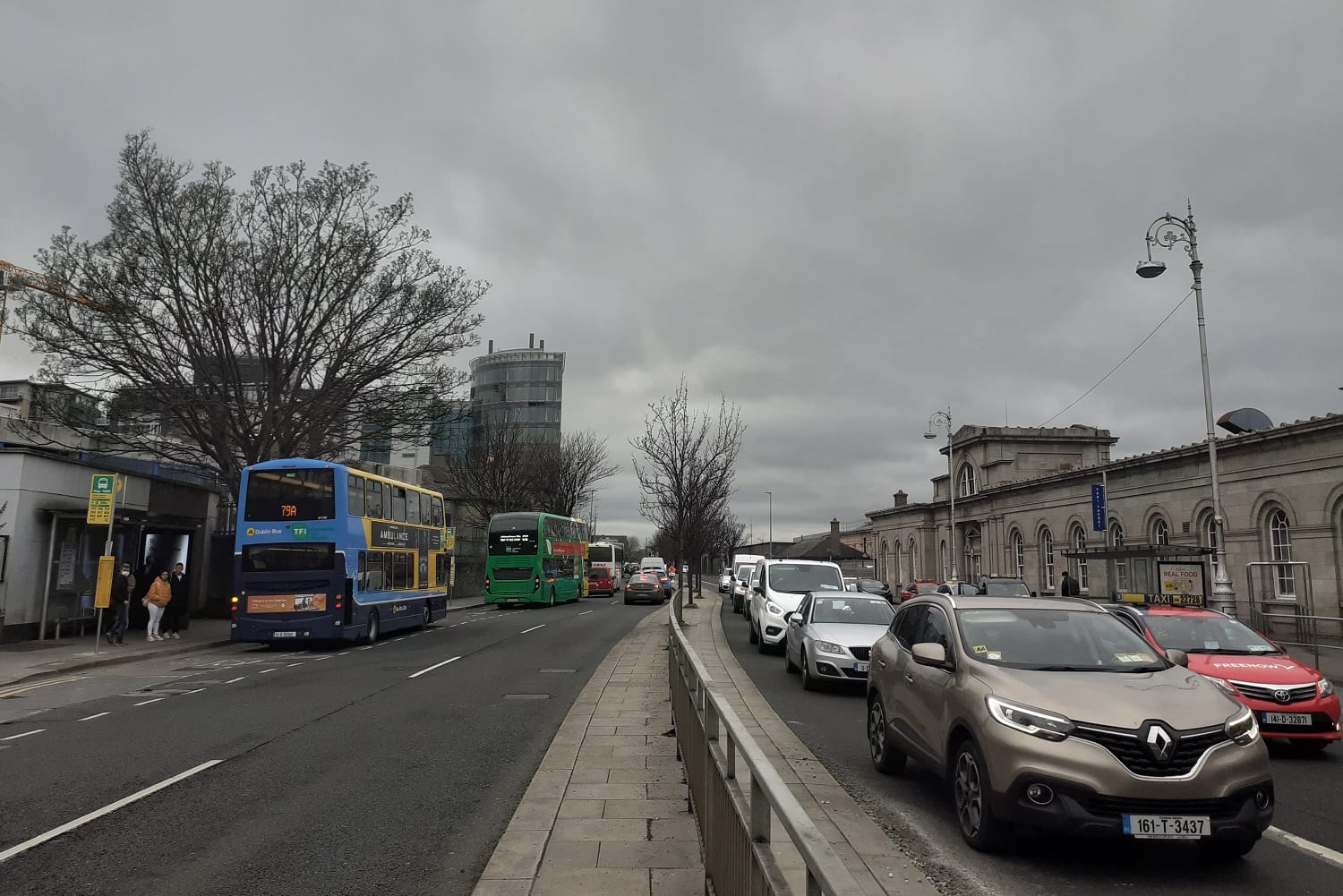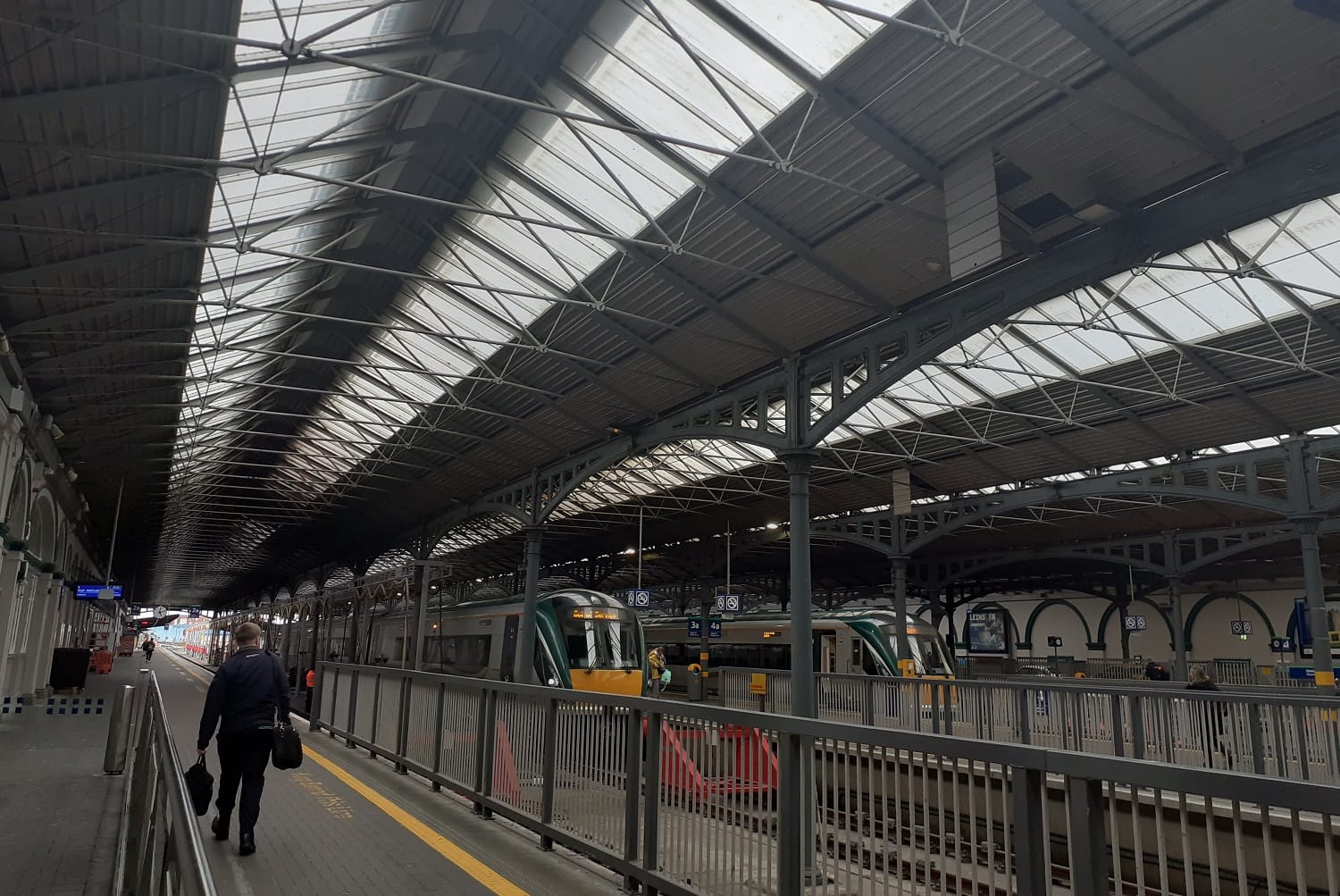What’s the best way to tell area residents about plans for a new asylum shelter nearby?
The government should tell communities directly about plans for new asylum shelters, some activists and politicians say.
In 2019, the level of nitrogen dioxide on high-traffic St John’s Road West breached legal limits, triggering an EU requirement to chart a path to keep it from happening again.

Magda Dziedzic says she doesn’t think about air quality while on her walk home from work to her apartment on Military Road.
“I’m just used to it, I don’t really think about it. The cars, they’ve been always there, since, well, my whole life,” she said on Monday.
But she’s glad that her windows don’t face onto St John’s Road West, she says, because it’s so smelly and noisy. It’s pretty polluted too.
In 2019, a monitoring station on St John’s Road West, next to Heuston Station, picked up levels of nitrogen dioxide (NO2) that breached legal limits, setting off a process forcing the government to show how it would fix it.
The resulting air-quality plan to improve NO2 levels doesn’t just address those around St John’s Road West and the busy train station.
Published in December 2021 by the four Dublin councils, it goes much further, with 14 broad measures some of which are already policy, from encouraging walking and cycling to relooking at national laws.
One theme of the plan is how responsibility for air quality is spread across all kinds of different bodies, while local authorities have limited powers to manage air quality. Councils want that to change, the report suggests.
“The Dublin local authorities will advocate to the relevant government department for enhanced legal powers in respect of air quality management be delegated to them,” it says.
It adds that “one enhanced legal power deserving of detailed consideration is for local authorities to be given the authority to introduce clean air zones or low emission zones”. In other words, the ability to ban vehicles with high emissions from parts of the city, or charge them to enter it.
Medical research has found links between air pollution and respiratory conditions and increased levels of strokes, cancer, and respiratory and cardiovascular disease, says the national Draft Clean Air Strategy, which is currently out for public consultation.
Under an EU directive, Ireland has to monitor its air quality, and keep pollution within certain limits.
If it – or any country – finds a breach, it has two years to prepare an air-quality plan to send to the European Commission, identifying the root causes and laying out measures to address the breach.
In 2019, air around the St John’s Road West monitoring station breached average annual limits for NO2. It came in at 43 micrograms per cubic metre, above the cap of 40 micrograms.
Transport-related emissions from the station, taxi rank, and cars driving past, caused the breach, says the air-quality plan, with peaks during rush hours. “This level of air pollution is wholly consistent with the levels of heavy traffic passing this monitoring station.”

In 2019, 2020 and 2021, there weren’t any more breaches at the 14 national monitoring stations in Dublin or elsewhere in the country, the plan says.
Provisional figures in the air-quality plan for 2021 do suggest high annual average rates of NO2, albeit still within limits, at the monitoring station in Blanchardstown (30.8 micrograms), and outside Pearse Street Station (35.5 micrograms).
In 2021, the level recorded by the St John’s Road West station was 33 micrograms, the data suggests, below the limit.
St John’s Road West isn’t a pleasant place to wait for a bus home, said Hannah Brannigan on Monday, pulling her headphones off. It’s noisy and clogged with constant traffic, she says.
“You kind of just have to zone out of it, because it’s just like, there’s a lot going on,” she says. She’s not often conscious of the air quality, though. After thinking about it for a moment, she says that it smells and feels unpleasant.
“But it’s just such a busy, like, area, that I don’t even know what they would do,” she says.
The Dublin region air-quality plan has 14 measures that cover traffic management and making it less attractive for people to own cars, some of which are underway, while others are planned for the future.
Those include some things local authorities can do: aiming for “15-minute neighbourhoods”, where residents can get most of what they need within a short walk, (which are set to feature prominently in Dublin City Council’s next development plan); public, workplace and residential parking controls; getting more people to walk and cycle; and rolling out electric vehicle charging points.
The plan also mentions there should be more monitoring, as this could lead to quicker action on breaches of pollution limits. A new national air-quality monitoring station would be installed in the north inner-city at some point, it says.
And bringing in new air-quality enabling legislation, such as “providing for the delegation of legal powers to appropriate bodies, including local authorities to introduce enhanced air quality measures”.
Currently, councils don’t have the powers to bring in low-emissions zones, or clean-air zones, the Dublin region air-quality plan says.
But it points to findings in a March 2021 study for the Department of Transport, that bringing in clean-air zones or low-emission zones could reduce NO2 emissions from transport by between 60 to 71 percent.
The plan suggests that the Air Pollution Act 1987 should be looked at, with an eye to making changes to allow for low-emissions zones, or for the minister to delegate powers to councils to bring them in, or if any amendments to that act are needed.
“Furthermore, an overall appraisal into the feasibility of introducing Low Emission Zones in the Dublin region where appropriate to be carried out,” the plan says.
A “low-emissions zone” for Dublin has been on the cards since at least December 2019, when the council’s head of traffic, Brendan O’Brien, said it was something the council was looking at for all, or part, of the city.
But the council has to wait for the Department of Environment and Climate before furthering this idea, said a spokesperson for Dublin City Council on Friday 4 March.

John Gallagher, an air quality expert at Trinity College Dublin, says that enforcement is necessary for a low-emissions zone to work. “There’s infrastructural requirements, to put the technology and the resources in place to enforce it.”
The Five Cities report mentions two enforcement methods used in other European cities: a number plate recognition system, or a colour-coded sticker scheme.
Gallagher says that some drivers could take alternative routes to avoid the costs of a low-emissions zone. “That might take you through new routes and create increased congestion in areas that previously were not problematic areas.”
“So it’s a very delicate decision process to make that call, because the last thing we want to do with the St John’s Road situation is to move the pollution problem elsewhere,” he says.
Dziedzic, standing near her apartment building off St John’s Road West, says she’d like to see a low-emissions zone in Dublin.
“Definitely around the city centre. Because it’s always so busy. There’s lots of cars, and probably it would be so much nicer,” she says. “Walking along the quays, would be a nicer walk. It’s not as enjoyable as it could be.”
Get our latest headlines in one of them, and recommendations for things to do in Dublin in the other.